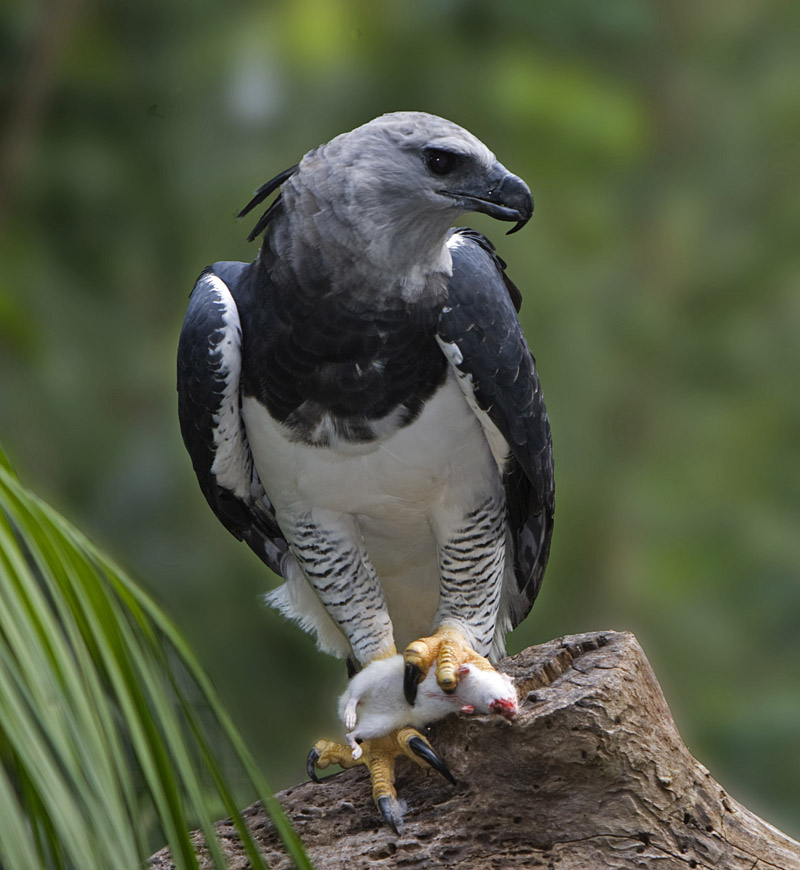The Harpy Eagle (Harpia harpyja) is one of the largest and most powerful birds of prey in the world, and it is found exclusively in the tropical rainforests of Central and South America. With a wingspan of up to 7 feet and sharp talons that can reach up to 5 inches in length, the Harpy Eagle is an apex predator that feeds on a wide range of prey, including monkeys, sloths, and other birds.
However, despite its impressive size and strength, the Harpy Eagle is facing a number of threats in the wild, including habitat loss, hunting, and poaching. In this essay, we will explore the conservation challenges facing the Harpy Eagle and the efforts being made to protect this iconic species in the Amazon rainforest.

What are the threats faced by the Harpy Eagle?
The Harpy Eagle is considered to be a near-threatened species by the International Union for Conservation of Nature (IUCN), and its population is estimated to be declining due to habitat loss, hunting, and other human activities. The primary threat to the Harpy Eagle is habitat loss, as the tropical rainforests of Central and South America are being rapidly destroyed for agriculture, logging, and other human activities. The Harpy Eagle requires large areas of intact forest to hunt and breed, and as these areas become fragmented and degraded, the eagle’s habitat becomes increasingly unsuitable for survival.
In addition to habitat loss, the Harpy Eagle is also threatened by hunting and poaching. In some parts of its range, the Harpy Eagle is hunted for its feathers, which are used in traditional headdresses and other cultural items. The eagles are also sometimes hunted for food, as their meat is considered a delicacy in some regions. Although hunting is illegal in most countries where the Harpy Eagle is found, enforcement of these laws is often weak or non-existent, and poaching continues to be a major threat to the species.
How is the Harpy Eagle being conserved?
Despite these challenges, there are a number of efforts underway to protect the Harpy Eagle and its habitat in the Amazon rainforest. One of the most important strategies for protecting the Harpy Eagle is the conservation of its habitat. In order to ensure that the Harpy Eagle has access to suitable areas for hunting and breeding, conservationists are working to protect large areas of intact forest and to prevent further deforestation and fragmentation of the rainforest. This includes working with local communities to develop sustainable land-use practices that allow for economic development while also protecting the rainforest and its wildlife.
Another key strategy for protecting the Harpy Eagle is the monitoring and research of its population and behavior. Scientists are studying the behavior of Harpy Eagles in the wild to better understand their habitat requirements, breeding habits, and other aspects of their ecology. This research is used to inform conservation efforts and to develop strategies for protecting the species.
In addition to habitat conservation and research, there are also a number of initiatives focused specifically on the protection of Harpy Eagles from hunting and poaching. These efforts include increased enforcement of hunting and poaching laws, as well as educational campaigns aimed at reducing demand for Harpy Eagle feathers and meat. By raising awareness of the importance of the Harpy Eagle to local communities and beyond, conservationists hope to reduce the threat of poaching and ensure that the species continues to thrive in the wild.
Conclusion
One notable success story in the conservation of the Harpy Eagle is the work being done by the Harpy Eagle Project in Panama. This project, which is a collaboration between the Peregrine Fund and the Panama Audubon Society, aims to protect the Harpy Eagle and its habitat in the forests of Panama through a combination of conservation, research, and education initiatives.
Help us Help Them! Think Wildlife Foundation is a non profit organization with various conservation initiatives. Our most prominent campaign is our Caring for Pari intiative. Pari is a rehabilitated elephant at the Wildlife SoS Hospital. 25% of the profits from our store are donated to the elephant hospital for Pari. Other than buying our wonderful merchandise, you could donate directly to our Caring For Pari fundraiser.
Written by: Sanghmitra Singh
